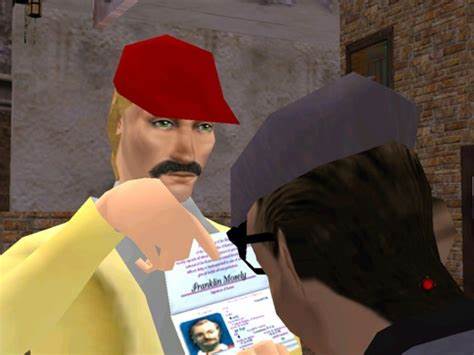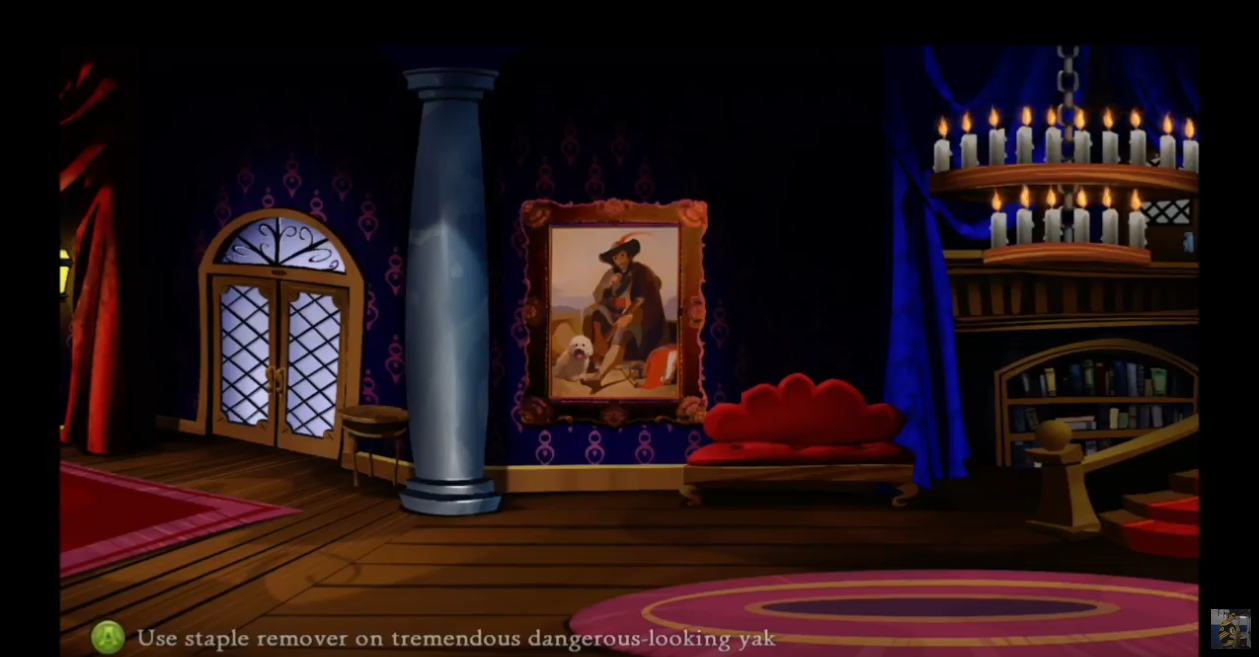In the game Gabriel Knight 3, you must impersonate a detective. To do so, you have to steal the detective's passport, draw a mustache on it, rip some of a cat's fur off, and use maple syrup to attach the cat fur to your face as a fake mustache.
This puzzle is so stupid that there's a whole Wikipedia article about it. It's even blamed for killing the whole adventure game genre - there's an old article by Erik Wolpaw (a writer on HL2, Portal and Psychonauts) called "Death of Adventure Games" which squarely places the blame on the cat hair mustache puzzle.

I think the criticism of this puzzle was more fatal to the genre than the puzzle itself. Good adventure game puzzles are pretty much all cat-hair-mustache puzzles. If your 'puzzle' is straightforward common sense, then it's not a puzzle, it's a fetch quest. If you need a key to open a lock, or a pen to write a letter, or a fake mustache to use as a fake mustache, that's not a puzzle. You can make the objects as wacky as you like, and it's still not a puzzle: needing an apology frog to write an apology isn't a puzzle. (Remembering things to write on the frog isn't a puzzle either.) The whole point of a good puzzle is that the objects involved will definitely not be used for their intended purpose. The one thing you can be sure of when you pick up a fake mustache in a good adventure game is that it damn well won't be used as fake mustache.
Here are some puzzle solutions from original LucasArts games:
- Use a monkey to loosen a nut (a monkey wrench, geddit?)
- Use spaghetti to make a wig
- Use dance steps as a map
- Use tofu as a mask
- Use white-out to turn a black cat into a skunk
Here are some puzzle solutions from the latest Monkey Island game:
- Use an "apology frog" to write an apology
- Use a knife to cut things (a lot)
- Use a recipe book as a recipe book
- Use a joke book as a joke book
- Use crackers to distract a parrot
- Use keys to open locks, over and over and over again
I don't get anything out of these 'puzzles'. It's a straightforward process of "look in inventory/world for obviously correct object". I can't think of any examples from the new game where an object was used in a satisfyingly unusual way.
Ron Gilbert seems to think these puzzles are very satisfying as long as the player sees the problem first:
Ideally, the crevice should be found before the rope that allows the player to descend. What this does in the player's mind is set up a challenge. He knows he need to get down the crevice, but there is no route. Now the player has a task in mind as he continues to search. When a rope is spotted, a light goes on in his head and the puzzle falls into place. For a player, when the design works, there is nothing like that experience.
Why Adventure Games Suck (2004)
I would be utterly disappointed to find out that the solution to descending the crevice is to happen upon a convenient rope. There needs to be a third stage here for me. The player needs to know that they need to get into the crevice; they must see some object; and then they must have a period of reflection, lateral thinking, and trial and error which leads to them realising "aha! I can use (seemngly unrelated object) to get down there!". Without that third stage, the puzzle is a dud for me.
In the 90s I used to play adventure games straight from a walkthrough. (I had to print the walkthrough, because these were dialup days and you couldn't go on the internet whenever you wanted!) This didn't ruin the fun because the puzzles themselves were funny. The objects used together were comically unlikely, which MI1 made full use of in the governor's mansion scene - the verb/noun combos were funny even though you couldn't see what was going on.

On top of that, whenever you solved a puzzle you were rewarded with an amusing animation or line of dialogue. It was even fun to read ahead in the walkthrough and try to imagine what scenario could possibly warrant "use rollerskates on mummy".
Back to Ron Gilbert, who needs the puzzles to make sense and be guessable:
Puzzles and their solutions need to make sense. They don't have to be obvious, just make sense. The best reaction after solving a tough puzzle should be, "Of course, why didn't I think of that sooner!" The worst, and most often heard after being told the solution is, "I never would have gotten that!"
I've thought "I never would have gotten that!" many times, but usually in the sense of "...because the designer was much funnier and more creative than me. What a great idea!" (And of course, I was a kid with very little cultural knowledge when I played early LucasArts games, which meant I had almost zero chance of knowing what ipecac syrup or a glove slap was. If I hadn't been able to enjoy thinking "I would never have gotten that, but now I understand!" I'd probably have given up playing entirely.)
In the new Monkey Island, the puzzles are much more logical so you can't enjoy them for their inherent humour. I definitely thought "Oh right, I should have thought of that" a few times, but it just made me feel bored.
The cat hair mustache puzzle is infinitely preferable to lock-and-key puzzles. The idea of creating a fake mustache to impersonate someone who doesn't have a mustache, and making that OK by drawing the mustache on, is genuinely funny. It's a joke, one that pokes fun at the genre by playing with your expectations. Maybe it wasn't signposted enough, maybe it didn't fit with the generally more realistic tone of the game, but at least it's such a deranged line of thought that you'll remember it twenty years later.
Adventure game writers: don't let fear of cat hair mustache criticism hold you back. Make some weird shit. Use cartoon logic. Confound and irritate your players! Just make sure you give them a walkthrough...